Abstract
1. The fate of orally administered 14C-labelled l-α-methyldopa has been examined in three normal men and in eight hypertensive patients who responded to the drug and three who did not. 2. The output of 14C in the urine in 2 days and in the faeces in 4 days was not very different in any of the subjects. The normals excreted about 40% of the dose in the urine and 60% in the faeces, the responders 52% (range 35–60%) and 45% and the non-responders 42% and 41%. Most of the urinary 14C radioactivity was eliminated in 24h after dosing. 3. The main metabolite in the urine was free and conjugated α-methyldopa (normal men, 23%; responders, 37%; non-responders, 25% of the dose). Free and conjugated 3-O-methyl-α-methyldopa was about 4% in all subjects, total amines (α-methyldopamine and 3-O-methyl-α-methyldopamine) about 6% and ketones (mainly 3,4-dihydroxyphenylacetone) about 3%. 4. The output of α-methyldopamine (2–4% of dose), 3-O-methyl-α-methyldopamine (0.3%) and 3,4-dihydroxyphenylacetone (3–5%) was similar in the one normal and two responders examined. 5. The faecal 14C in all subjects was unchanged l-α-methyldopa. 6. In general, the amounts of the metabolites in the urine in normal men and in responding and non-responding patients were quantitatively similar, except in one non-responding patient who converted nearly two-thirds of the absorbed drug into amines and ketones. There appeared to be no correlation between metabolites in the urine and response or lack of response to the drug. 7. In two normal subjects 70–80% of d-α-methyldopa was excreted unchanged in the faeces. Of the absorbed compound most (9–14% of the dose) was excreted as the free and conjugated drug together with a small amount (1–2%) of 3-O-methyl-α-methyldopa. No amines and only traces of ketone were excreted.
Full text
PDF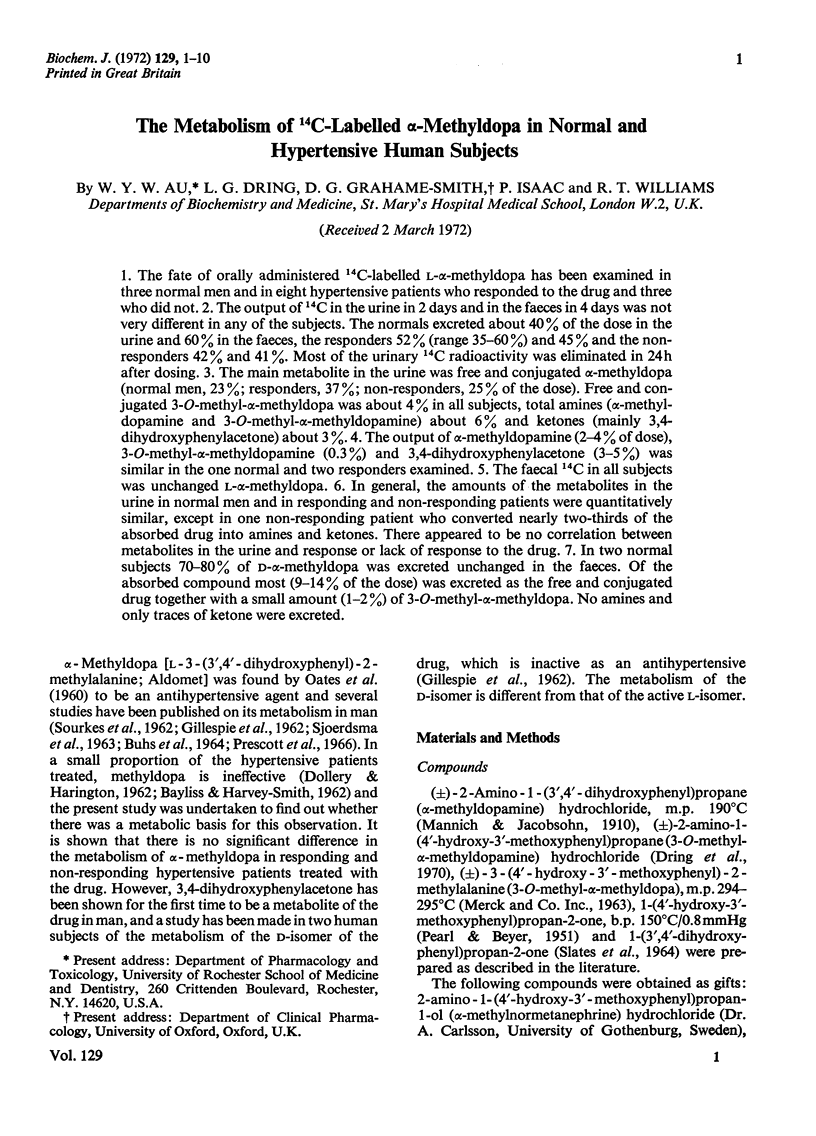
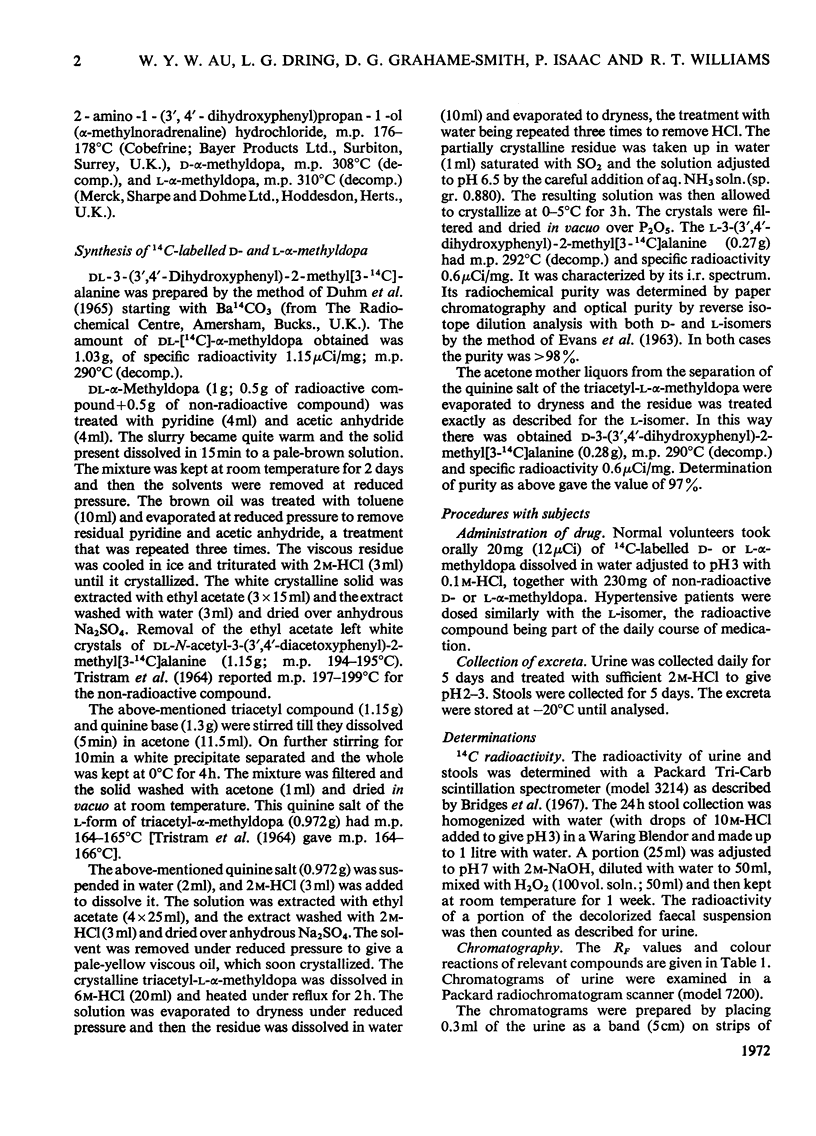
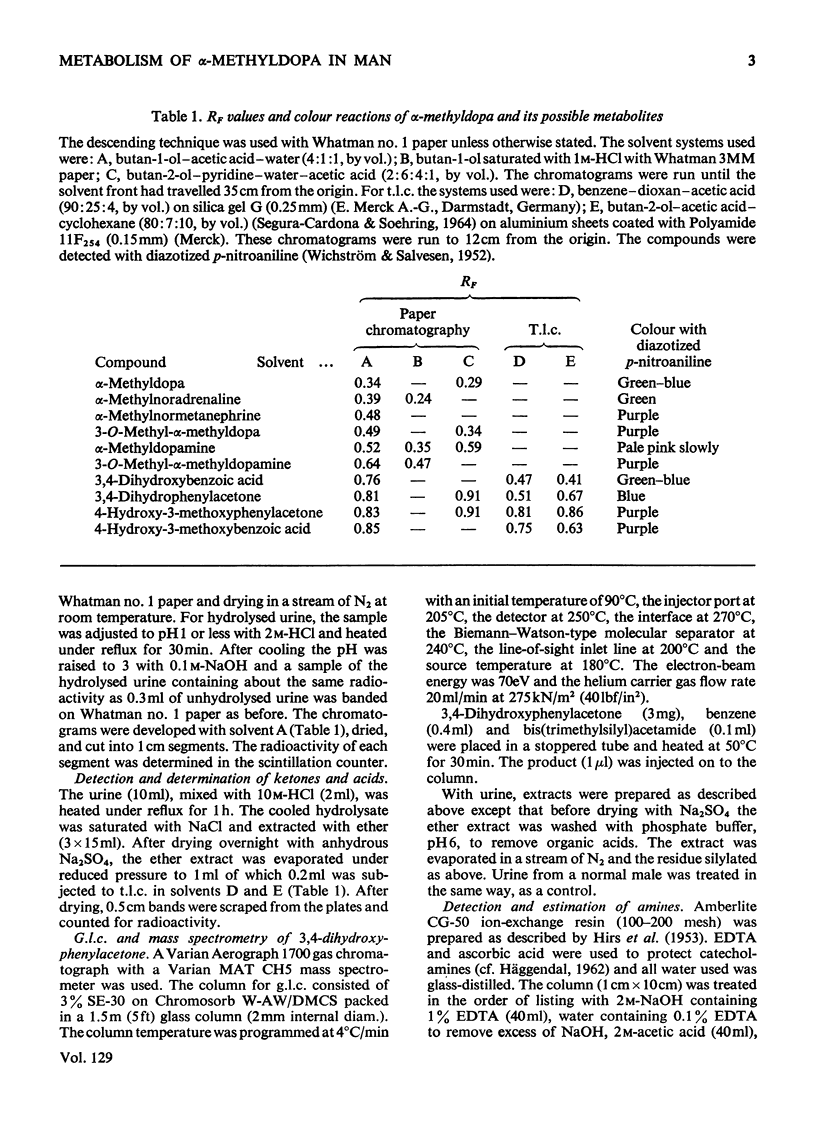
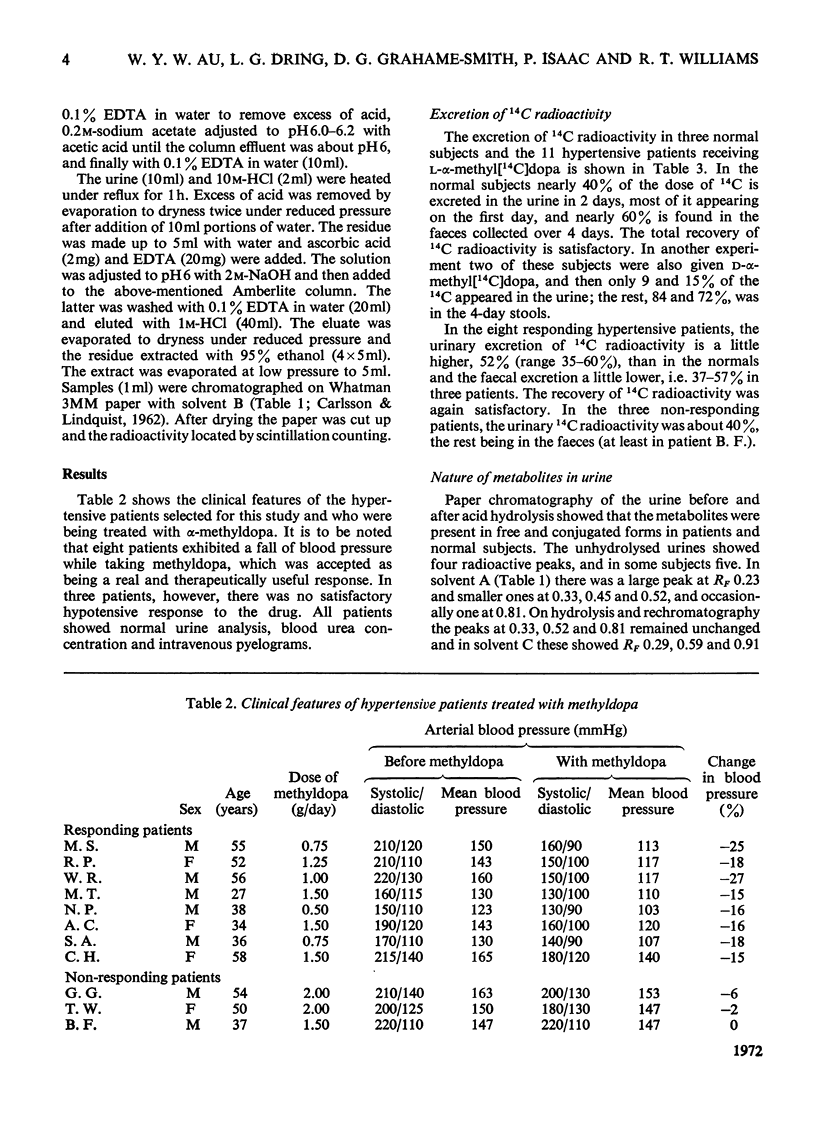
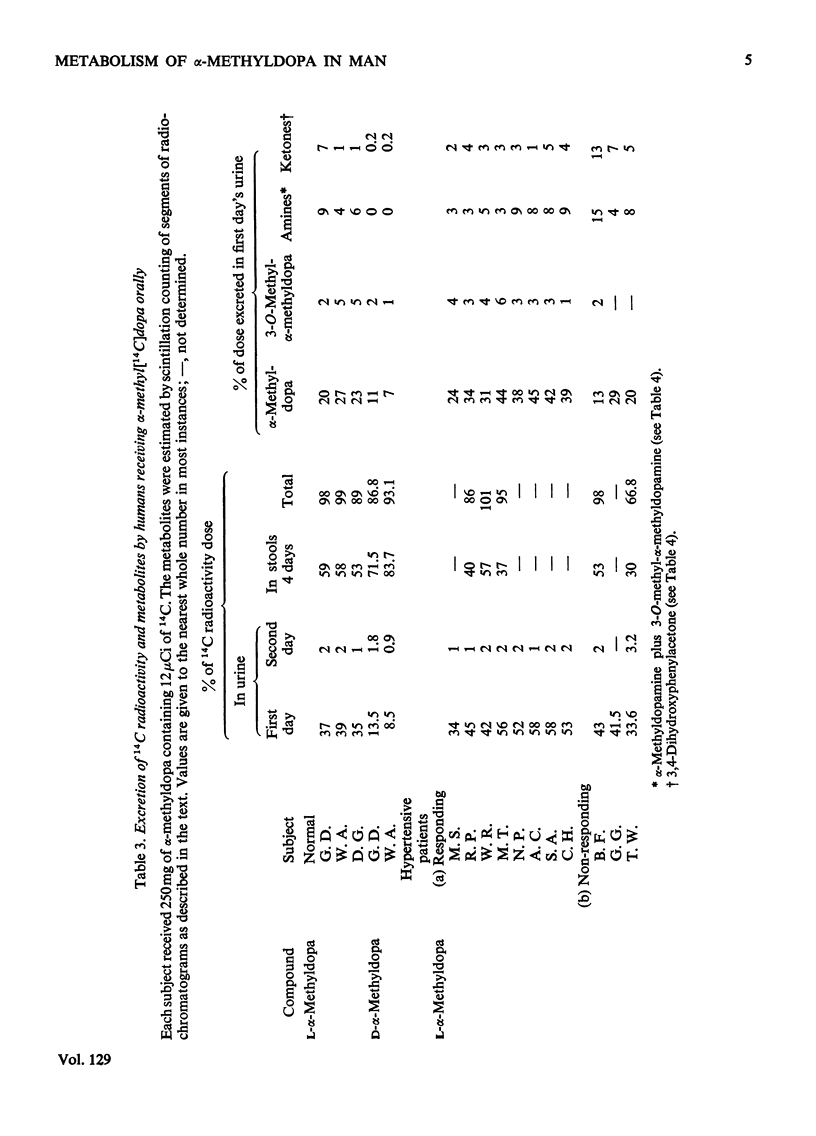
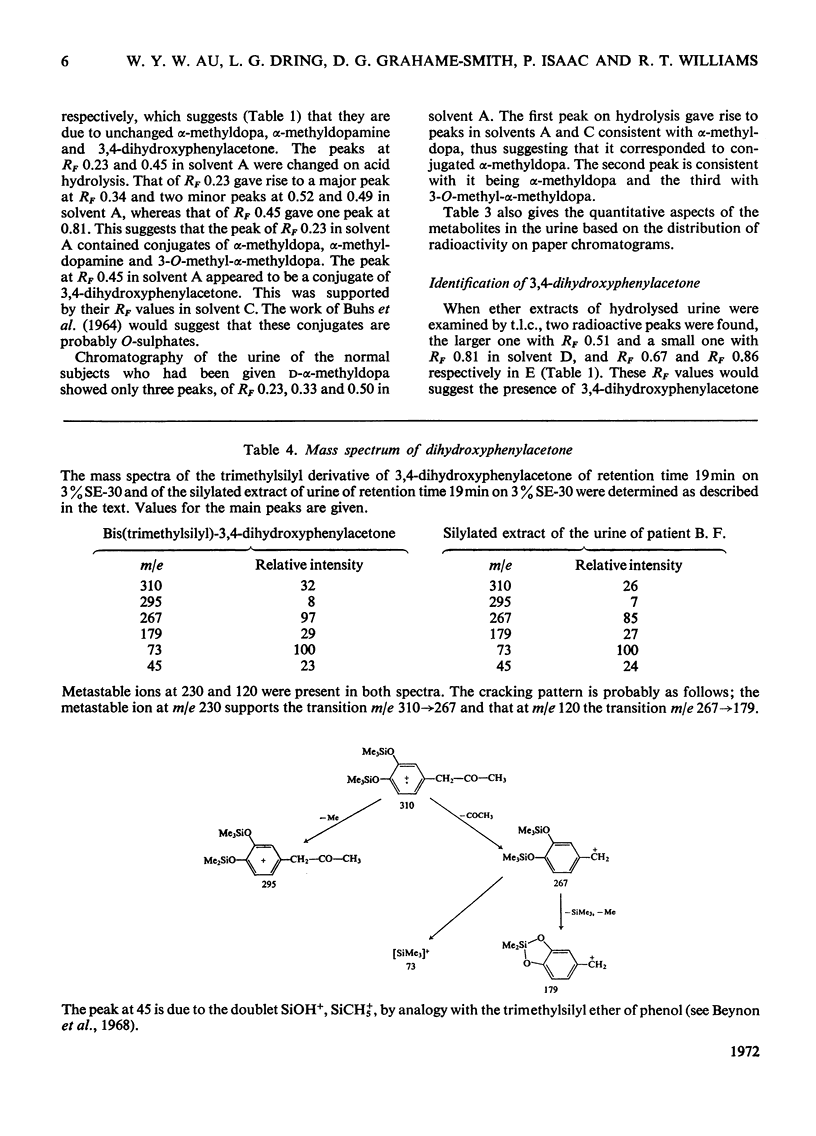

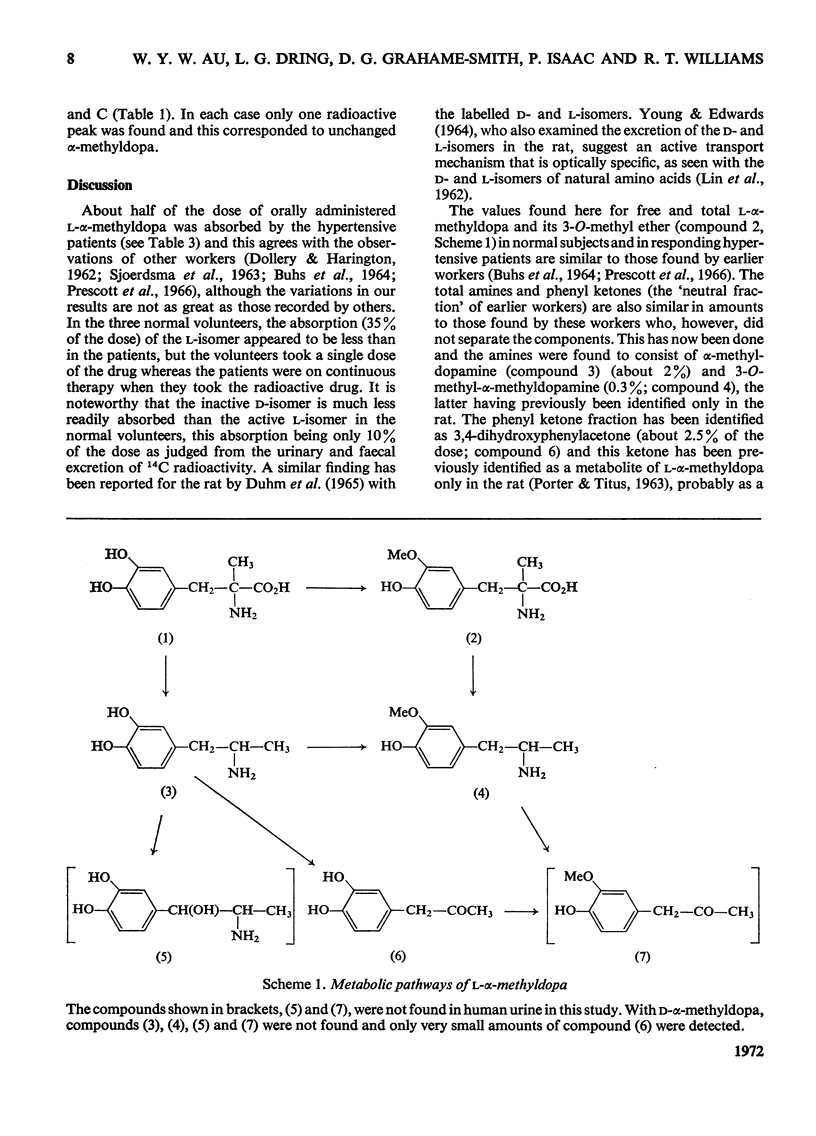
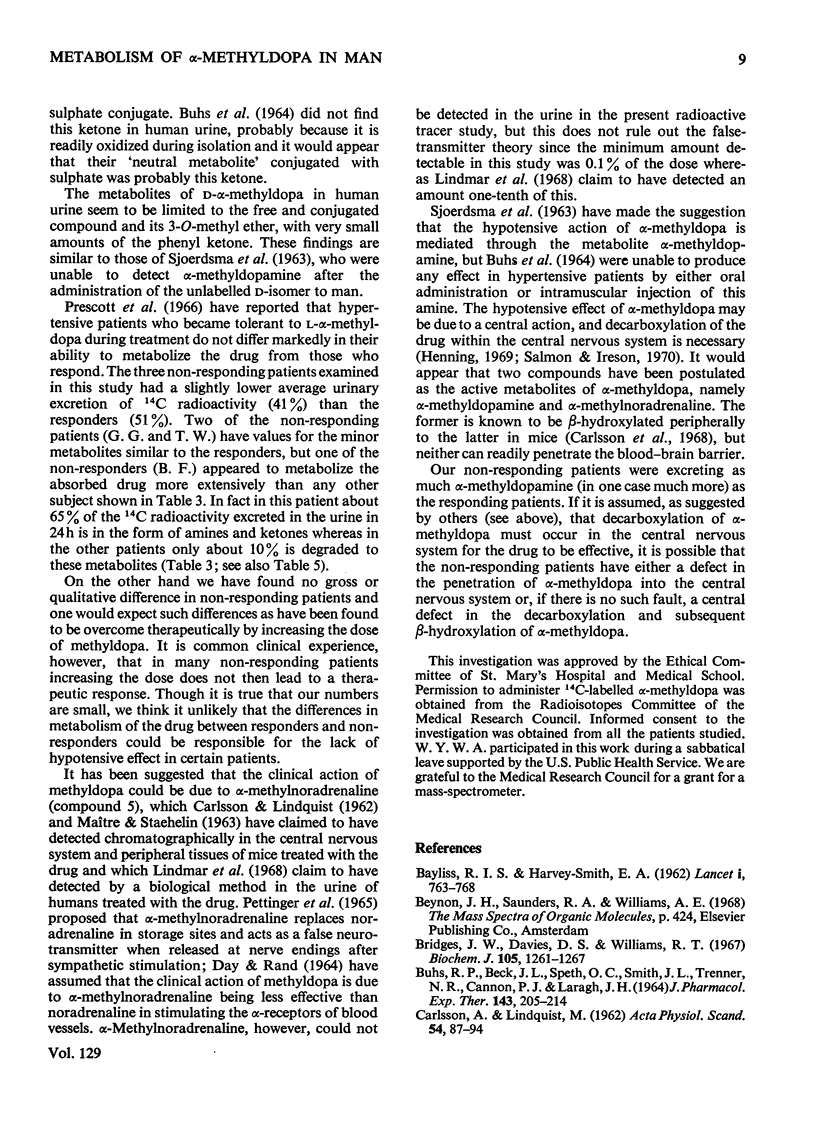
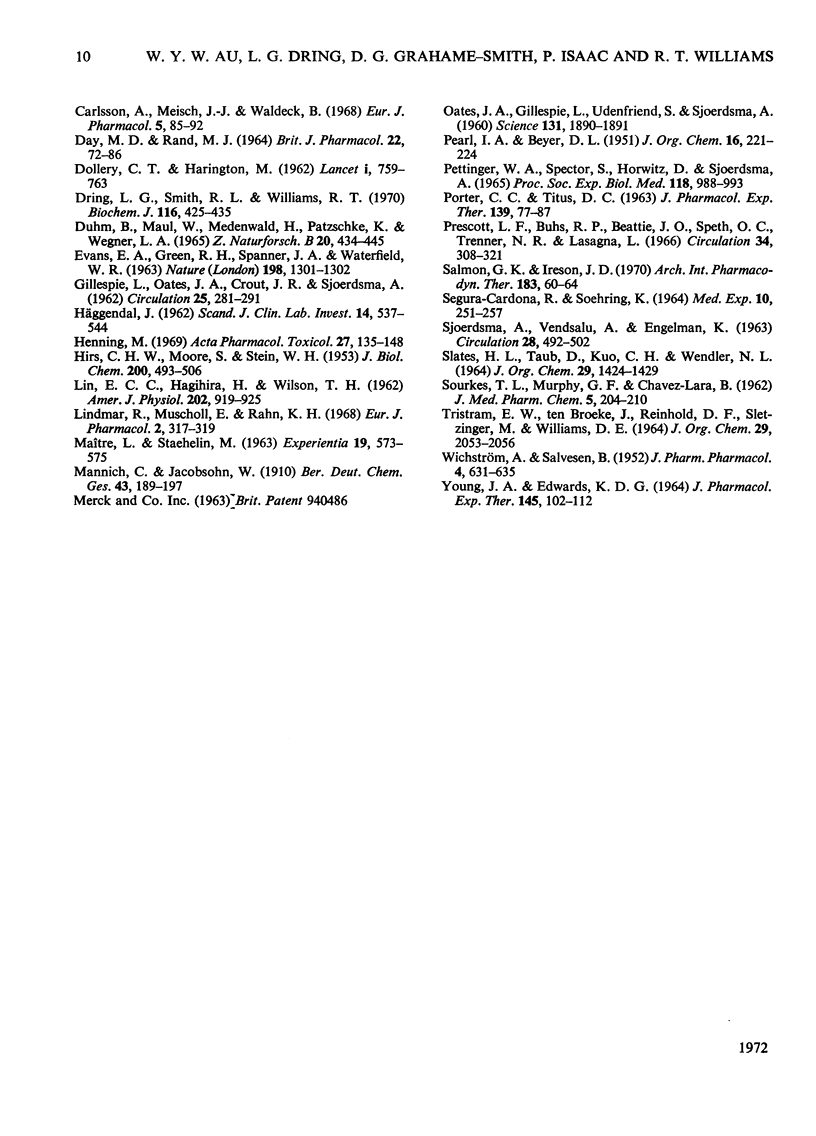
Selected References
These references are in PubMed. This may not be the complete list of references from this article.
- BAYLISS R. I., HARVEY-SMITH E. A. Methyldopa in the treatment of hypertension. Lancet. 1962 Apr 14;1(7233):763–768. doi: 10.1016/s0140-6736(62)91782-8. [DOI] [PubMed] [Google Scholar]
- BUHS R. P., BECK J. L., SPETH O. C., SMITH J. L., TRENNER N. R., CANNON P. J., LARAGH J. H. THE METABOLISM OF METHYLDOPA IN HYPERTENSIVE HUMAN SUBJECTS. J Pharmacol Exp Ther. 1964 Feb;143:205–214. [PubMed] [Google Scholar]
- Bridges J. W., Davies D. S., Williams R. T. The fate of ethyltin and diethyltin derivatives in the rat. Biochem J. 1967 Dec;105(3):1261–1267. doi: 10.1042/bj1051261. [DOI] [PMC free article] [PubMed] [Google Scholar]
- Carlsson A., Meisch J. J., Waldeck B. On the beta-hydroxylation of (+-)-alpha-methyldopamine in vivo. Eur J Pharmacol. 1968 Dec;5(1):85–92. doi: 10.1016/0014-2999(68)90160-x. [DOI] [PubMed] [Google Scholar]
- DAY M. D., RAND M. J. SOME OBSERVATIONS ON THE PHARMACOLOGY OF ALPHA-METHYLDOPA. Br J Pharmacol Chemother. 1964 Feb;22:72–86. doi: 10.1111/j.1476-5381.1964.tb01545.x. [DOI] [PMC free article] [PubMed] [Google Scholar]
- DOLLERY C. T., HARINGTON M. Methyldopa in hypertension. Clinical and pharmacological studies. Lancet. 1962 Apr 14;1(7233):759–763. doi: 10.1016/s0140-6736(62)91781-6. [DOI] [PubMed] [Google Scholar]
- DUHM B., MAUL W., MEDENWALD H., PATZSCHKE K., WEGNER L. A. TIEREXPERIMENTELLE UNTERSUCHUNGEN MIT ALPHA-METHYL-DOPA-14C UNTER BESONDERER BERUECKSICHTIGUNG DER OPTISCHEN ISOMEREN. I. SYNTHESE, RESORPTION, AUSSCHEIDUNG UND METABOLISMUS. Z Naturforsch B. 1965 May;20:434–445. [PubMed] [Google Scholar]
- Dring L. G., Smith R. L., Williams R. T. The metabolic fate of amphetamine in man and other species. Biochem J. 1970 Feb;116(3):425–435. doi: 10.1042/bj1160425. [DOI] [PMC free article] [PubMed] [Google Scholar]
- GILLESPIE L., Jr, OATES J. A., CROUT J. R., SJOERDSMA A. Clinical and chemical studies with alpha-methyl-dopa in patients with hypertension. Circulation. 1962 Feb;25:281–291. doi: 10.1161/01.cir.25.2.281. [DOI] [PubMed] [Google Scholar]
- HAGGENDAL J. On the use of strong exchange resins for determinations of small amounts of catechol amines. Scand J Clin Lab Invest. 1962;14:537–544. doi: 10.3109/00365516209051276. [DOI] [PubMed] [Google Scholar]
- HIRS C. H. W., MOORE S., STEIN W. H. A chromatographic investigation of pancreatic ribonuclease. J Biol Chem. 1953 Feb;200(2):493–506. [PubMed] [Google Scholar]
- LIN E. C., HAGIHIRA H., WILSON T. H. Specificity of the transport system for neutral amino acids in the hamster intestine. Am J Physiol. 1962 May;202:919–925. doi: 10.1152/ajplegacy.1962.202.5.919. [DOI] [PubMed] [Google Scholar]
- Lindmar R., Muscholl E., Rahn K. H. Effects of rest and physical activity on the urinary excretion of noradrenaline and alpha-methylnoradrenaline in human subjects treated with alpha-methyldopa. Eur J Pharmacol. 1968 Feb;2(4):317–319. doi: 10.1016/0014-2999(68)90084-8. [DOI] [PubMed] [Google Scholar]
- MAITRE L., STAEHELIN M. EFFECT OF ALPHA-METHYL-DOPA ON MYOCARDIAL CATECHOLAMINES. Experientia. 1963 Nov 15;19:573–575. doi: 10.1007/BF02150996. [DOI] [PubMed] [Google Scholar]
- OATES J. A., GILLESPIE L., UDENFRIEND S., SJOERDSMA A. Decarboxylase inhibition and blood pressure reduction by alpha-methyl-3,4-dihydroxy-DL-phenylalanine. Science. 1960 Jun 24;131(3417):1890–1891. doi: 10.1126/science.131.3417.1890. [DOI] [PubMed] [Google Scholar]
- PETTINGER W. A., SPECTOR S., HORWITZ D., SJOERDSMA A. RESTORATION OF TYRAMINE PRESSOR RESPONSES IN RESERPINE-TREATED ANIMALS BY METHYLDOPA AND ITS AMINE METABOLITES. Proc Soc Exp Biol Med. 1965 Apr;118:988–993. doi: 10.3181/00379727-118-30025. [DOI] [PubMed] [Google Scholar]
- PORTER C. C., TITUS D. C. Distribution and metabolism of methylopa in the rat. J Pharmacol Exp Ther. 1963 Jan;139:77–87. [PubMed] [Google Scholar]
- Prescott L. F., Buhs R. P., Beattie J. O., Speth O. C., Trenner N. R., Lasagna L. Combined clinical and metabolic study of the effects of alpha-methyldopa on hypertensive patients. Circulation. 1966 Aug;34(2):308–321. doi: 10.1161/01.cir.34.2.308. [DOI] [PubMed] [Google Scholar]
- SEGURA-CARDONA R., SOEHRING K. DUENNSCHICHTCHROMATOGRAPHISCHER NACHWEIS KLEINSTER MENGEN VON KATECHOLAMINEN UND DEREN DERIVATEN. Med Exp Int J Exp Med. 1964;10:251–257. [PubMed] [Google Scholar]
- SJOERDSMA A., VENDSALU A., ENGELMAN K. STUDIES ON THE METABOLISM AND MECHANISM OF ACTION OF METHYLDOPA. Circulation. 1963 Oct;28:492–502. doi: 10.1161/01.cir.28.4.492. [DOI] [PubMed] [Google Scholar]
- SOURKES T. L., MURPHY G. F., CHAVEZ-LARA B. A METABOLIC STUDY OF ALPHA-METHYL-BETA-(3,4-DIHYDROXYPHENYL)-DL-ALANINE IN MAN. J Med Pharm Chem. 1962 Jan;5:204–210. doi: 10.1021/jm01236a020. [DOI] [PubMed] [Google Scholar]
- Salmon G. K., Ireson J. D. A correlation between the hypotensive action of methyldopa and its depression of peripheral sympathetic function. Arch Int Pharmacodyn Ther. 1970 Jan;183(1):60–64. [PubMed] [Google Scholar]
- WICKSTROM A., SALVESEN B. The separation and identification of some sympathomimetic amines by paper partition chromatography. J Pharm Pharmacol. 1952 Sep;4(9):631–635. doi: 10.1111/j.2042-7158.1952.tb13193.x. [DOI] [PubMed] [Google Scholar]
- YOUNG J. A., EDWARDS K. D. STUDIES ON THE ABSORPTION, METABOLISM AND EXCRETION OF METHYLDOPA AND OTHER CATECHOLS AND THEIR INFLUENCE ON AMINO ACID TRANSPORT IN RATS. J Pharmacol Exp Ther. 1964 Jul;145:102–112. [PubMed] [Google Scholar]


